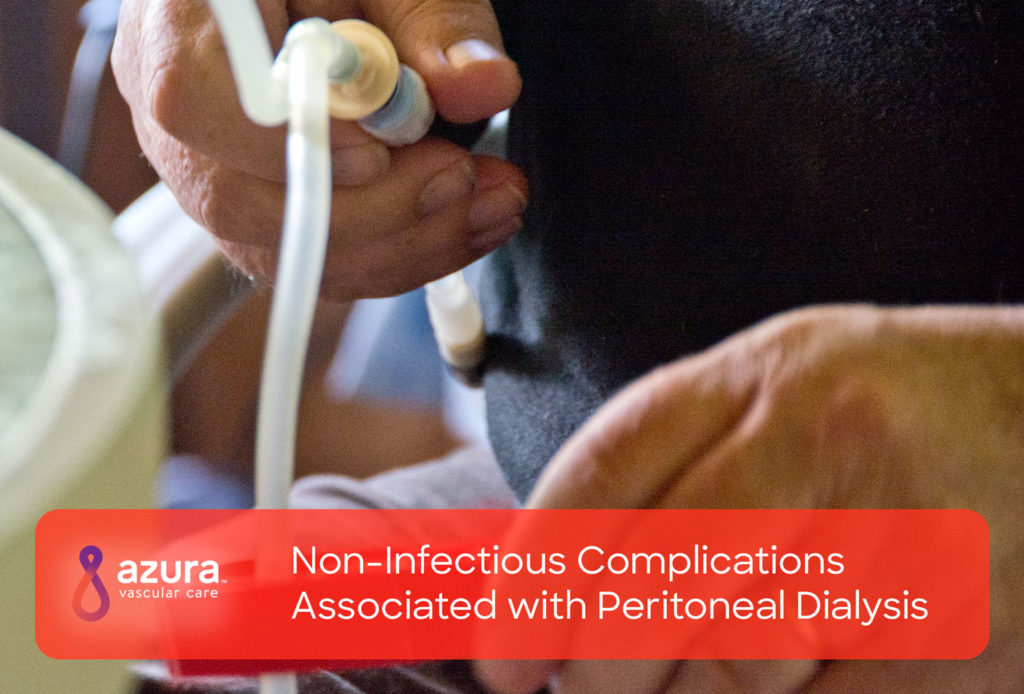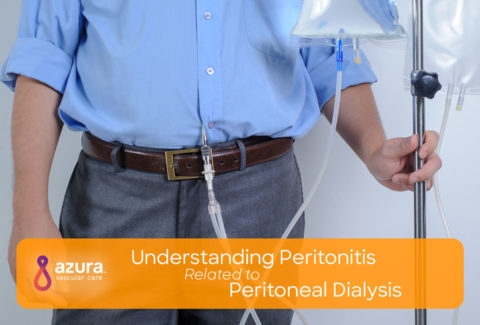
Peritoneal dialysis (PD) is associated with a risk for infection such as peritonitis, which is inflammation of the peritoneum, or the membrane lining of the abdominal wall. (i) However, PD comes with its own set of non-infectious complications as well—many of which can be addressed promptly at a vascular access center. Knowing more about these complications and their symptoms can empower you or a loved one to contact a vascular specialist at the right time to receive immediate treatment.
6 Potential Non-Infectious Complications You May Experience with Peritoneal Dialysis
Weight Gain
The dialysis fluid used in PD tends to be highly concentrated in dextrose to help move a higher amount of fluid and waste into the abdominal cavity. Dextrose is sugar—most of which may be absorbed by your body during each dialysis session. (ii) Over time, this can lead to weight gain as a result of your taking in several hundred extra calories per day from the dialysis fluid.
PD dialysis can also spike your blood sugar level to put you at higher risk for type 2 diabetes. (iii) If you have a PD catheter and are gaining excess weight, talk to your nephrologist about changes you can make to your diet that can fight weight gain without compromising dialysis treatment.
Hernia
Holding fluid in your abdomen for long periods of time can put a strain on your abdominal wall and muscles which may cause them to weaken. (iii) This increases the risk of hernia. A hernia can occur shortly after PD catheter placement but more commonly occurs as a late complication one year following PD initiation. (iv) Signs you may have a hernia include the sudden appearance of bumps or bulges in your belly, feeling a bulge in the groin area, and the leaking of PD fluid from the catheter exit site. (v)
Leaking of Dialysis Fluid
Pericatheter leaks, which are leaks that occur around the PD catheter, are reported to affect up to 40% of PD patients. (iv) The leaking of dialysis fluid is one of the more common PD catheter complications. PD patients affected by this complication may notice that their clothing or dressing around the dialysis access is wet following a PD exchange.
Patients at highest risk for the leaking of dialysis fluid tend to have weak abdominal wall muscles, particularly those who suffer from diabetes and weakened immunity. However, these individuals may be able to avoid the leaking of dialysis fluid by strengthening their abdominal walls with exercise and physical activity.
Pain
Back pain and infusion pain are commonly experienced by some PD patients. Excess pressure and weight in the abdomen can put undue pressure on spinal nerves to cause back pain. You may be able to prevent and relieve your back pain by performing exercises that strengthen the abdominal muscles. If the prescribed amount of dialysate used during an exchange is contributing to your back pain, a modification to the PD prescription may be needed.
Infusion pain can be caused by hypersensitivity to the dialysis solution, which can be addressed by adding more bicarbonate as a buffer to the fluid to balance its pH level. (iv) Incorrect PD catheter placement can also cause infusion pain, especially when the tip of the catheter touches the bladder, pelvic wall, or rectum.
Obstruction
Obstruction is another mechanical complication associated with PD catheters. Obstruction occurs when the PD catheter is placed too close to the intestine or when the catheter migrates to cause poor outflow of the dialysis solution. This complication can often be corrected by PD catheter repositioning and, in some cases, a surgical revision will be needed. (iv)
Perforation
Perforation is one of the rarest PD catheter complications and occurs when the catheter pierces into the bladder, gallbladder, bowel, or another organ. (iv) Perforation can be caused by the insertion of a too-long catheter or by the poor positioning of the catheter into the peritoneum. Symptoms of perforation may include watery diarrhea, abdominal pain, fever, and signs of infection. (vi)
How to Treat PD Catheter Complications
PD catheter complications can be safely and effectively treated by a vascular specialist at a vascular access center. A doctor who specializes in access care and maintenance can perform an evaluation, discuss your symptoms, and arrange for you to receive immediate treatment, to fix and reposition your PD catheter. If you or a loved one is experiencing abdominal pain or any other symptoms you think may be related to your dialysis access, contact your nephrologist to obtain a referral to avascular access center immediately to discuss your treatment options.
Azura Vascular Care is devoted to helping you fully understand how to properly care for your dialysis access and can treat complications associated with PD. Call 866.996.9729 to schedule an appointment with a vascular specialist today.
Sources:
(i) Akoh, J. A. (2012). Peritoneal dialysis associated infections: An update on diagnosis and management. World Journal of Nephrology 1 (4):106-122.
(ii) National Institute of Diabetes and Digestive and Kidney Diseases. (2010, September). Peritoneal dialysis: Dose & adequacy. Retrieved February 24, 2019, from https://www.niddk.nih.gov/health-information/kidney-disease/kidney-failure/peritoneal-dialysis/dose-adequacy.
(iii) Mayo Clinic. (2018, March 22). Peritoneal dialysis. Retrieved February 24, 2019, from https://www.mayoclinic.org/tests-procedures/peritoneal-dialysis/about/pac-20384725.
(iv) Advanced Renal Education Program. (2016, July). Complications of PD catheters. Retrieved February 24, 2019, from https://www.advancedrenaleducation.com/content/complications-pd-catheters.
(v) Home Dialysis Central. (n.d.). Hernias and peritoneal dialysis. Retrieved February 24, 2019, from https://www.homedialysis.org/life-at-home/articles/hernias-and-peritoneal-dialysis.
(vi) Fujiwara, M., Soda, T., Okada, T., Kanamaru, H., Inoue, T., & Ogawa, O. (2017). Bowel perforation by a peritoneal dialysis catheter: Report of two cases. BMC Nephrology 18 (312).


